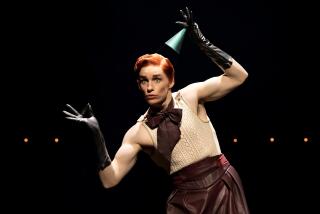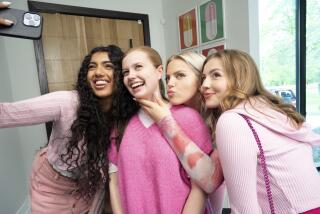Review: ‘Charlie and the Chocolate Factory’ leaves a bitter taste
LONDON — All the best ingredients in the world don’t guarantee a great chocolate bar, as Willy Wonka would be the first to attest. There’s magic in the preparation, a special alchemy that can elude even a master confectioner’s best effort.
The same evidently holds true for new musicals. The latest proof is “Charlie and the Chocolate Factory,” which had its much-anticipated West End opening last week at the historic Theatre Royal Drury Lane.
The cream of British and American theater teamed up to bring to the stage this favorite Roald Dahl fable about a sweet-natured poor kid named Charlie who wins a golden ticket to enter a competition with a bunch of greedy brats for a grand prize at Willy Wonka’s chocolate factory. But the result is surprisingly bland, a musical that will leave more demanding theatergoers of all ages scrunching up their faces and wondering where the flavor went.
PHOTOS: Hollywood stars on stage
This innocuous production, which begins with a tongue-in-cheek documentary on the history of chocolate, lacks the tangy originality of “Willy Wonka & the Chocolate Factory,” the classic 1971 movie starring Gene Wilder as the half-demented candy man spinning sugar into gluttonous fantasy. Making matters more invidious, the show pales in comparison to the current Dahl hit drawing crowds in London and New York, “Matilda the Musical.”
Now “Matilda” for me didn’t quite live up to the transcendent hype promulgated on both sides of the Atlantic. Quite frankly, I was prepared to love “Charlie” more. It’s not just that the novel held a greater place in my childhood affections, though it did. It’s that with so many dab hands involved the material was bound to be born anew.
The score of this newly minted show is by Marc Shaiman and Scott Wittman, the Tony-winning songwriting duo who made “Hairspray” the most compulsively danceable show to come around this young century.
The staging is by Oscar-winning director Sam Mendes, whose diverse body of work (including the films “American Beauty” and “Skyfall” and the musicals “Cabaret” and “Gypsy”) you’d assume would have equipped him for Dahl’s distinctive blend of one part sweet, two parts sour.
Peter Darling, the man who set “Matilda” and “Billy Elliot: The Musical” in distinctive motion, choreographed. And Douglas Hodge, the versatile British actor who won a Tony for his flamboyantly affecting performance in the Broadway revival of “La Cage Aux Folles,” stars as the captivatingly mad Willy Wonka.
What could possibly go wrong with such a top-notch crew?
PHOTOS: Arts and culture in pictures by The Times
The answer, I’m afraid, is a great deal. Shaiman and Wittman still seem to be trying on styles, skipping from patter numbers to traditional ballads to rap eruptions. The production plays fast and loose with the period (the Dickensian poverty of Charlie and his family shifts unexpectedly to today’s computer age with pit stops to what vaguely looks like the 1950s and the 1970s), and the score follows suit, never settling on an era or even a genre.
The music strives for a British tone but keeps reverting to American pop idioms, Shaiman and Wittman’s strong suit. Chalk it up to familiarity but “Pure Imagination,” the Leslie Bricusse and Anthony Newley song from “Willy Wonka & the Chocolate Factory” that’s performed near the end of Mendes’ production, is not just the most memorable number but it’s the one song that seems to emerge naturally from the story.
The inclusion of “Pure Imagination” made me wonder why the creators didn’t also import the Oompa Loompa numbers from the film, those catchy morality tunes perfectly in sync with Dahl’s unforgiving worldview. Wittman and Shaiman’s lyrics offer plenty of clever word play and they mostly steer clear of sentimentality, but if ever there was a musical to leave an audience humming the sets, it’s this one.
Except that the strange thing is that Mark Thompson’s scenic design underwhelms once we get inside the chocolate factory, which David Greig’s book is curiously in no hurry to get to. The first half, spent largely in Charlie’s dilapidated family shack, is far more scenically original, perhaps because Thompson must use more of his own imagination to conjure the setting.
PHOTOS: Google Doodles of 2013
The household is drawn as though it were in a graphic novel by Samuel Beckett. Charlie’s two sets of invalid grandparents occupy adjoining beds, and the cramped poverty has a kind of edge of the world picturesqueness — cozy yet apocalyptic.
Four actors are cast in the role of Charlie. Louis Suc is the performer I caught, and he was utterly adorable, a Charlie who should be immediately cast in a revival of “Oliver!” should this production close a few years earlier than expected.
Nigel Planer makes a winning Grandpa Joe, the kindly old man who rises from his bed to accompany Charlie on his tour of the chocolate factory, where one by one the child contestants (all of whom are alternately played by three or four actors) go down in sugary flames.
These avaricious little monsters aren’t given enough time to become more than their most dislikable characteristics. But there’s a lot of plot to scurry through in the second act and neither Greig’s book nor Mendes’ direction allows the actors a moment to settle in.
The story is updated here and there, but remains essentially the same: one kid plunges down a chocolate lake, another blows up into a blueberry, etc., etc. The original movie (so good I never got around to the 2005 Tim Burton version starring Johnny Depp) is much more vivid than this stage production — the special effects just aren’t all that special.
How the Oompa Loompa actors are costumed to appear so small is an engrossing enigma, but visually the chocolate factory scenes are not all that enticing. If Dahl were to include me as the sixth child on the tour, I’d be the sourpuss with my arms folded asking everyone what’s so wonderful about this edible wonderland.
I’d hate to imagine the comeuppance Willy Wonka would have in store for me. Hodge’s version of the character is menacing in an audacious way that doesn’t seem particularly geared to children. He looks trapped in a scary adult head.
Wilder at least had those wide sympathetic eyes to soften some of the diabolical mania. There are no close-up opportunities at the Theatre Royal Drury Lane for us to become better acquainted with Hodge’s Willy. He remains a distant figure, though Dahl would no doubt appreciate that his creation isn’t being overly sweetened for the mass market.
Not sure how happy he’d be with the overall result, however. “Charlie and the Chocolate Factory” needs to be sent back to the test kitchen before it heads to Broadway. The recipe isn’t working, but the tale is too good for the creative team not to keep tinkering.
More to Read
The biggest entertainment stories
Get our big stories about Hollywood, film, television, music, arts, culture and more right in your inbox as soon as they publish.
You may occasionally receive promotional content from the Los Angeles Times.







